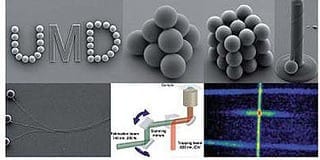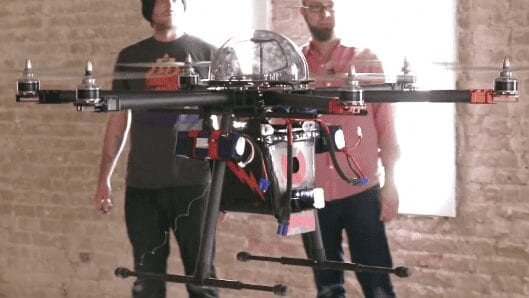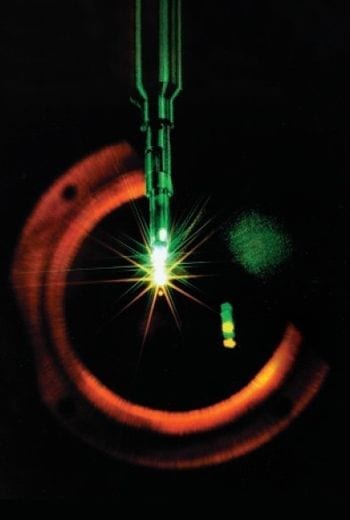
A low-power photodetection system can harness enough energy to power an autonomous sensor and monitoring network
Light detectors are used extensively in daily life as brightness sensors and as receivers for remote control devices in electrical gadgets, for example. However, operating these detectors requires electrical energy, which limits their versatility.
Now, Kui Yao and colleagues from the A*A*STAR Institute of Materials Research and Engineering in Singapore have developed a photodetector that can harvest just small quantities of detected light to generate enough energy to power a sensing signal transmission through a radio-frequency transmitter.
While the energy contained in a beam of light can be converted into electricity, this energy is not usually sufficient to continuously power an electrical circuit. Even the use of batteries to power a circuit is impractical in many circumstances, explains Yao. “Use of photosensors may take place under extremely harsh conditions intolerable to batteries, or involve environmental monitoring network systems where it may be too expensive or unrealistic to maintain batteries for each sensor.”
Operating an electrical circuit under low-power circumstances requires a buildup of energy, which must be generated by the photodetector. However, commonly used photodetector materials, which are based on semiconductors, lose too much energy for this to occur. “Conventional photodetectors can’t accumulate the minute photovoltaic energy and then harness it to drive a load in a sustainable manner,” explains Yao.
To overcome such energy losses, Yao and colleagues developed photodetectors made fromferroelectric compounds. These insulating materials can separate electrical charges as well as store them with low losses. Ferroelectric detectors can also generate a larger electrical voltage than semiconductors, making it easier for them to power other electrical components.
The researchers connected their ferroelectric detector to a specially designed electrical circuit, which is mechanically opened and closed by a switch in the form of a piezoelectric cantilever. Any generated electricity is temporarily stored in the ferroelectric detector and a capacitor. Once the electrical charge of the capacitor is sufficiently high, the cantilever changes its shape and closes the electrical circuit. This activates a commercial radio transmitter.
So far, the team’s main challenge in developing the device has been to minimize electrical losses. Remarkably, Yao and his team have shown that almost 70 per cent of the accumulated electrical charge can be retrieved from the capacitor — even ten minutes after the light source has been switched off. This advantage provides the team’s device with the potential for use in a wide range of applications, such as wireless optical sensors and monitoring networks.
The Latest on: Autonomous sensor and monitoring network
[google_news title=”” keyword=”Autonomous sensor and monitoring network” num_posts=”10″ blurb_length=”0″ show_thumb=”left”]
via Google News
The Latest on: Autonomous sensor and monitoring network
- Collaborative Robot Market Size Expected to Reach USD 35.55 Bn by 2033 | Industries Seeking Agile Automation Solutionson May 8, 2024 at 10:00 am
The global collaborative robot market is anticipated to grow from USD 1.75 billion to USD 35.55 billion in 10 years. The expansion of the collaborative robot market can be attributed to the rising ...
- Mapping brain function, safer autonomous vehicles are focus of Schmidt Transformative Technology fundon May 8, 2024 at 8:58 am
Two projects — one that maps the function of the brain’s neuronal network in unprecedented detail and another ... This project aims to enhance the safety and reliability of autonomous vehicles and ...
- What is the Future for Porsche Drivers in an Autonomous World?on May 7, 2024 at 5:00 pm
Are those manufacturers ahead with regard to autonomous driving ... interface to the electronic map and a highly advanced sensor system - in particular the camera belt, which provides 360-degree ...
- Supporting your air quality monitoring system when you can’t get to iton May 7, 2024 at 2:05 am
Each time we think we have found a spectacularly remote monitoring location, an even more inaccessible spot is reported by one of our users. Full-day trips to visit a location have now been ...
- Pentagon technology hub sees lower transition rate, higher value dealson May 2, 2024 at 12:02 pm
a partnership with the Air Force focused on providing algorithms that can command large numbers of airborne weapons and sensors. DIU also transitioned two cyber projects — both focused on threat ...
- Driving Forward: Unveiling 10 Transformative Trends in Connected Transportation Techon May 1, 2024 at 8:14 am
Innovation is the driving force propelling us forward into a future where connectivity reigns supreme. From autonomous vehicles to smart infrastructure, the realm of connected transportation is ...
- Autonomous Cars and Driverless Cars Market Size Worth $2137.2 Million By 2030: IndustryARCon April 29, 2024 at 5:13 pm
The Global Autonomous Cars and Driverless Cars Market size is predicted to reach $2137.2 billion by 2030, growing at a CAGR of 18.3% during the forecast period 2024-2030 according to the latest market ...
- Autonomous and Sensor Technology: A Resilient Rebound on the IoT Horizonon April 29, 2024 at 11:48 am
New data from AltIndex (supplemented by data from Statista Market Insights) sheds light on the global market for autonomous and sensor technologies.
- Lethal AI Weapons Are on the Rise. What’s Next?on April 29, 2024 at 5:00 am
The development of lethal autonomous weapons (LAWs), including AI-equipped drones, is on the rise. The US Department of Defense, for example, has earmarked US$1 billion so far for its Replicator ...
- From Self-Driving Cars to Electric Vehicles: The Latest in Automotive Innovationon April 29, 2024 at 4:53 am
Buckle up, because the automotive industry is revving up with groundbreaking innovation! From self-driving cars to electric vehicles, the future of transportation is here. Join us as we take a closer ...
via Bing News










